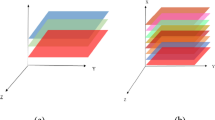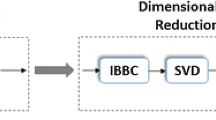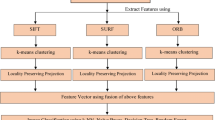Abstract
To further improve target detection performance of hyperspectral image, this paper presents a novel method named multi-scale analysis-based target detection (MATD). The proposed method first applies multi-scale wavelet analysis technology to extract multi-scale features of hyperspectral data. Then, these features are converted into a tensor form, and is processed and analyzed by using tensor analysis method. Through solving the tensor subspace, the reduced-dimension feature coefficients can be extracted. Finally, based on these feature coefficients, a better target detection result can be obtained by using the detection algorithm. Experimental results of real world hyperspectral data show that the proposed MATD method can effectively improve detection performance.













Similar content being viewed by others
References
Y. T. Wang, S. Q. Huang, D. Z. Liu, B. H. Wang, A new band removed selection method for target detection in hyperspectral image. J. Opt. 42(3), 208–213 (2013)
Jolliffe I T. Principal component analysis, 2nd edition, springer, 2002.
He X F, Cai D, Yan S C, et al. Neighborhood preserving embedding. Proceedings of the 10th IEEE Int’l Conf. Computer vision (ICCV’05), Beijing, China, 2005: 1208–1213.
He X F, Niyogi P. Locality preserving projections. Proceedings of Neural Information Processing Systerm, Vancouver, 2003.
T. H. Zhang, J. Yang, D. L. Zhao, X. L. Ge, Linear local tangent space alignment and application to face recognition. Neurocomputing Letters. 70(7–9), 1547–1553 (2007)
Lathauwer L D. Signal Processing based on Multilinear Algebra. Ph. D, Katholike Universiteit Leuven, Leuven, 1997.
H. Lu, K. N. Plataniotis, A. N. Venetsanopoulos, A survey of multilinear subspace learning for tensor data. Pattern Recognit. 44(7), 1540–1551 (2011)
Bengua J A, Phien H N, Tuan H D. Optimal feature extraction and classification of tensors via matrix product state decomposition\\Big Data, 2015 I.E. international Congress on, New York, 669–672.
Z. Hao, L. He, B. Chen, et al., A linear support higher-order tensor machine for classification. IEEE Trans. Image Process. 22(7), 2911–2920 (2013)
L. Zhang, F, Zhang L P, Tao D C, et al. A sparse and discriminative tensor to vector projection for human gait feature representation. Signal Processing 106, 245–252 (2015)
L. Zhang, F, Zhang L P, Tao D C, et al. Compression of hyperspectral remote sensing images by tensor approach. Neurocomputing 147, 358–363 (2015)
X. F. Liu, S. Bourennane, C. Fossati, Denoising of hyperspectral images using the PARAFAC model and statistical performance analysis. IEEE Trans. Geosci. Remote Sens. 50(10), 3717–3724 (2012)
G. Lu, L. Halig, D. Wang, et al., Spectral-spatial classification using tensor modeling for cancer detection with hyperspectral imaging. Proc. SPIE Int. Soc. Opt. Eng. 9034, 903413 (2014)
I. Daubechies, Ten lectures on wavelets [M] (Society for industrial and applied mathematics, Philadelphia, 1992)
X. Liu, S. Bourennane, C. Fossati, Denoising of hyperspectral images using the PARAFAC model and statistical performance analysis. IEEE Trans. Geosci. Remote Sens. 50(10), 3717–3724 (2012)
H. Gholizadeh et al., A decision fusion framework for hyperspectral subpixel target detection. Photogrammetrie - Fernerkundung - Geoinformation 3, 267–280 (2012)
S. Kraut, L. L. Scharf, The CFAR adaptive subspace detector is a scale-invariant GLRT. IEEE Trans. Signal Process. 47(9), 2538–2541 (1999)
D. Manolakis, D. Marden, G. A. Shaw, Hyperspectral image processing for automatic target detection applications. Lincoln Laboratory Journal 14(1), 79–116 (2003)
Acknowledgements
This work was supported by the National Natural Science Foundation of China under project No. 41174093 and No. 41574008.
Author information
Authors and Affiliations
Corresponding author
Rights and permissions
About this article
Cite this article
Wang, Y., Huang, S., Liu, Z. et al. Target detection for hyperspectral image based on multi-scale analysis. J Opt 46, 75–82 (2017). https://doi.org/10.1007/s12596-016-0334-5
Received:
Accepted:
Published:
Issue Date:
DOI: https://doi.org/10.1007/s12596-016-0334-5




